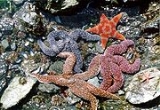
Ambulacraria
Encyclopedia
Ambulacraria is a clade
of invertebrates which includes echinoderm
s, hemichordates, and Xenoturbellida; a member of this group is called an ambulacrarian. This superphylum is largely identical to the superphylum Deuterostomia, except the phylum Chordata is not found in Ambulacraria.
The three living phyla, with representative organisms, are:
Fossil taxa that may lie on the stem lineage:
Clade
A clade is a group consisting of a species and all its descendants. In the terms of biological systematics, a clade is a single "branch" on the "tree of life". The idea that such a "natural group" of organisms should be grouped together and given a taxonomic name is central to biological...
of invertebrates which includes echinoderm
Echinoderm
Echinoderms are a phylum of marine animals. Echinoderms are found at every ocean depth, from the intertidal zone to the abyssal zone....
s, hemichordates, and Xenoturbellida; a member of this group is called an ambulacrarian. This superphylum is largely identical to the superphylum Deuterostomia, except the phylum Chordata is not found in Ambulacraria.
The three living phyla, with representative organisms, are:
- Phylum Echinodermata (sea starSea starStarfish or sea stars are echinoderms belonging to the class Asteroidea. The names "starfish" and "sea star" essentially refer to members of the class Asteroidea...
s, sea urchinSea urchinSea urchins or urchins are small, spiny, globular animals which, with their close kin, such as sand dollars, constitute the class Echinoidea of the echinoderm phylum. They inhabit all oceans. Their shell, or "test", is round and spiny, typically from across. Common colors include black and dull...
s, brittle starBrittle starBrittle stars or ophiuroids are echinoderms in the class Ophiuroidea closely related to starfish. They crawl across the seafloor using their flexible arms for locomotion. The ophiuroids generally have five long slender, whip-like arms which may reach up to in length on the largest specimens...
s, sea cucumbers, feather stars, sea lilies, etc.) - Phylum HemichordataHemichordataHemichordata is a phylum of marine deuterostome animals, generally considered the sister group of the echinoderms. They date back to the Lower or Middle Cambrian and include two main classes: Enteropneusta , and Pterobranchia. A third class, Planctosphaeroidea, is known only from the larva of a...
(acorn wormAcorn wormThe Acorn worms or Enteropneusta are a hemichordate class of invertebrates, closely related to the echinoderms. There are about 90 species of acorn worm in the world, the main species for research being Saccoglossus kowaleskii....
s, PterobranchiaPterobranchiaPterobranchia is a clade of small, worm-shaped animals. They belong to the hemichordata, and live in secreted tubes on the ocean floor. Pterobranchia feed by filtering plankton out of the water with the help of cilia attached to tentacles. There are about 30 known living species in the group.The...
, and possibly graptoliteGraptoliteGraptolithina is a class in the animal phylum Hemichordata, the members of which are known as Graptolites. Graptolites are fossil colonial animals known chiefly from the Upper Cambrian through the Lower Carboniferous...
s) - Phylum Xenoturbellida (two species of worm-like animals)
Fossil taxa that may lie on the stem lineage:
- ?Superphylum Ambulacraria#
- unranked clade CambroernidCambroernidThe Cambroernids are a clade containing the eldoniids and Herpetogaster-like forms....
a- unranked clade = Eldoniida
- † HerpetogasterHerpetogasterHerpetogaster is an extinct monotypic genus of animal from the Middle Cambrian Burgess Shale with a single species Herpetogaster collinsi. Six specimens of Herpetogaster are known from the Greater Phyllopod bed, where they comprise less than 0.01% of the community.-See also:* at the Fossil Wiki....
Caron, Conway Morris & Shu, 2010 - with one species: † Herpetogaster collinsi Caron, Conway Morris & Shu, 2010
- unranked clade Cambroernid

